标签:对比 amp format 自带 gap gas div mode 图片

代码:
%% ------------------------------------------------------------------------ %% Output Info about this m-file fprintf(‘\n***********************************************************\n‘); fprintf(‘ <DSP using MATLAB> Problem 8.32 \n\n‘); banner(); %% ------------------------------------------------------------------------ % ------------------------------------- % Ω=(2/T)tan(ω/2) % ω=2*[atan(ΩT/2)] % Digital Filter Specifications: % ------------------------------------- wp = 0.3*pi; % digital passband freq in rad ws = 0.4*pi; % digital stopband freq in rad Rp = 0.25; % passband ripple in dB As = 50; % stopband attenuation in dB Ripple = 10 ^ (-Rp/20) % passband ripple in absolute Attn = 10 ^ (-As/20) % stopband attenuation in absolute % Analog prototype specifications: Inverse Mapping for frequencies T = 1; % set T = 1 Fs = 1/T; OmegaP = (2/T)*tan(wp/2) % prototype passband freq OmegaS = (2/T)*tan(ws/2) % prototype stopband freq % Analog Elliptic Prototype Filter Calculation: [cs, ds] = afd_elip(OmegaP, OmegaS, Rp, As); % Calculation of second-order sections: fprintf(‘\n***** Cascade-form in s-plane: START *****\n‘); [CS, BS, AS] = sdir2cas(cs, ds) fprintf(‘\n***** Cascade-form in s-plane: END *****\n‘); % Calculation of Frequency Response: [db_s, mag_s, pha_s, ww_s] = freqs_m(cs, ds, 0.5*pi/T); % Calculation of Impulse Response: [ha, x, t] = impulse(cs, ds); % Impulse Invariance Transformation: %[b, a] = imp_invr(cs, ds, T); % Bilinear Transformation [b, a] = bilinear(cs, ds, Fs) [C, B, A] = dir2cas(b, a) % Calculation of Frequency Response: [db, mag, pha, grd, ww] = freqz_m(b, a); %% ----------------------------------------------------------------- %% Plot %% ----------------------------------------------------------------- figure(‘NumberTitle‘, ‘off‘, ‘Name‘, ‘Problem 8.32 Analog Elliptic lowpass‘) set(gcf,‘Color‘,‘white‘); M = 1.0; % Omega max subplot(2,2,1); plot(ww_s/pi, mag_s); grid on; %axis([-10, 10, 0, 1.2]); xlabel(‘ Analog frequency in \pi units‘); ylabel(‘|H|‘); title(‘Magnitude in Absolute‘); set(gca, ‘XTickMode‘, ‘manual‘, ‘XTick‘, [-0.4625, -0.3244, 0, 0.3244, 0.4625]); set(gca, ‘YTickMode‘, ‘manual‘, ‘YTick‘, [0, 0.0032, 0.9716, 1.0, 1.5]); subplot(2,2,2); plot(ww_s/pi, db_s); grid on; %axis([0, M, -50, 10]); xlabel(‘Analog frequency in \pi units‘); ylabel(‘Decibels‘); title(‘Magnitude in dB ‘); set(gca, ‘XTickMode‘, ‘manual‘, ‘XTick‘, [-0.4625, -0.3244, 0, 0.3244, 0.417, 0.458, 0.4625]); set(gca, ‘YTickMode‘, ‘manual‘, ‘YTick‘, [-50, -1, 0]); set(gca,‘YTickLabelMode‘,‘manual‘,‘YTickLabel‘,[‘50‘;‘ 1‘;‘ 0‘]); subplot(2,2,3); plot(ww_s/pi, pha_s/pi); grid on; %axis([-10, 10, -1.2, 1.2]); xlabel(‘Analog frequency in \pi nuits‘); ylabel(‘radians‘); title(‘Phase Response‘); set(gca, ‘XTickMode‘, ‘manual‘, ‘XTick‘, [-0.4625, -0.3244, 0, 0.3244, 0.4625]); set(gca, ‘YTickMode‘, ‘manual‘, ‘YTick‘, [-1:0.5:1]); subplot(2,2,4); plot(t, ha); grid on; %axis([0, 30, -0.05, 0.25]); xlabel(‘time in seconds‘); ylabel(‘ha(t)‘); title(‘Impulse Response‘); figure(‘NumberTitle‘, ‘off‘, ‘Name‘, ‘Problem 8.32 Digital Elliptic lowpass by bilinear‘) set(gcf,‘Color‘,‘white‘); M = 2; % Omega max subplot(2,2,1); plot(ww/pi, mag); axis([0, M, 0, 1.2]); grid on; xlabel(‘ Digital frequency in \pi units‘); ylabel(‘|H|‘); title(‘Magnitude Response‘); set(gca, ‘XTickMode‘, ‘manual‘, ‘XTick‘, [0, 0.3, 0.4, 1.6, 1.7, M]); set(gca, ‘YTickMode‘, ‘manual‘, ‘YTick‘, [0, 0.0032, 0.9716, 1]); subplot(2,2,2); plot(ww/pi, pha/pi); axis([0, M, -1.1, 1.1]); grid on; xlabel(‘Digital frequency in \pi nuits‘); ylabel(‘radians in \pi units‘); title(‘Phase Response‘); set(gca, ‘XTickMode‘, ‘manual‘, ‘XTick‘, [0, 0.3, 0.4, 1.6, 1.7, M]); set(gca, ‘YTickMode‘, ‘manual‘, ‘YTick‘, [-1:1:1]); subplot(2,2,3); plot(ww/pi, db); axis([0, M, -80, 10]); grid on; xlabel(‘Digital frequency in \pi units‘); ylabel(‘Decibels‘); title(‘Magnitude in dB ‘); set(gca, ‘XTickMode‘, ‘manual‘, ‘XTick‘, [0, 0.3, 0.37, 0.4, 1.6, 1.7, M]); set(gca, ‘YTickMode‘, ‘manual‘, ‘YTick‘, [-60, -50, -1, 0]); set(gca,‘YTickLabelMode‘,‘manual‘,‘YTickLabel‘,[‘60‘;‘50‘;‘ 1‘;‘ 0‘]); subplot(2,2,4); plot(ww/pi, grd); grid on; %axis([0, M, 0, 35]); xlabel(‘Digital frequency in \pi units‘); ylabel(‘Samples‘); title(‘Group Delay‘); set(gca, ‘XTickMode‘, ‘manual‘, ‘XTick‘, [0, 0.3, 0.4, 1.6, 1.7, M]); %set(gca, ‘YTickMode‘, ‘manual‘, ‘YTick‘, [0:5:35]); figure(‘NumberTitle‘, ‘off‘, ‘Name‘, ‘Problem 8.32 Pole-Zero Plot‘) set(gcf,‘Color‘,‘white‘); zplane(b,a); title(sprintf(‘Pole-Zero Plot‘)); %pzplotz(b,a); % ---------------------------------------------- % Calculation of Impulse Response % ---------------------------------------------- figure(‘NumberTitle‘, ‘off‘, ‘Name‘, ‘Problem 8.32 Imp & Freq Response‘) set(gcf,‘Color‘,‘white‘); t = [0:0.01:90]; subplot(2,1,1); impulse(cs,ds,t); grid on; % Impulse response of the analog filter axis([0,90,-0.2,0.3]);hold on n = [0:1:90/T]; hn = filter(b,a,impseq(0,0,90/T)); % Impulse response of the digital filter stem(n*T,hn); xlabel(‘time in sec‘); title (sprintf(‘Impulse Responses T=%2d‘,T)); hold off % Calculation of Frequency Response: [dbs, mags, phas, wws] = freqs_m(cs, ds, 2*pi/T); % Analog frequency s-domain [dbz, magz, phaz, grdz, wwz] = freqz_m(b, a); % Digital z-domain %% ----------------------------------------------------------------- %% Plot %% ----------------------------------------------------------------- subplot(2,1,2); plot(wws/(2*pi), mags/T,‘b‘, wwz/(2*pi*T), magz, ‘r‘); grid on; xlabel(‘frequency in Hz‘); title(‘Magnitude Responses‘); ylabel(‘Magnitude‘); text(-0.8,0.15,‘Analog filter‘, ‘Color‘, ‘b‘); text(0.8,0.4,‘Digital filter‘, ‘Color‘, ‘r‘);
运行结果:
这里主要放双线性变化法的代码。
通带、阻带绝对指标,模拟滤波器截止频率指标,
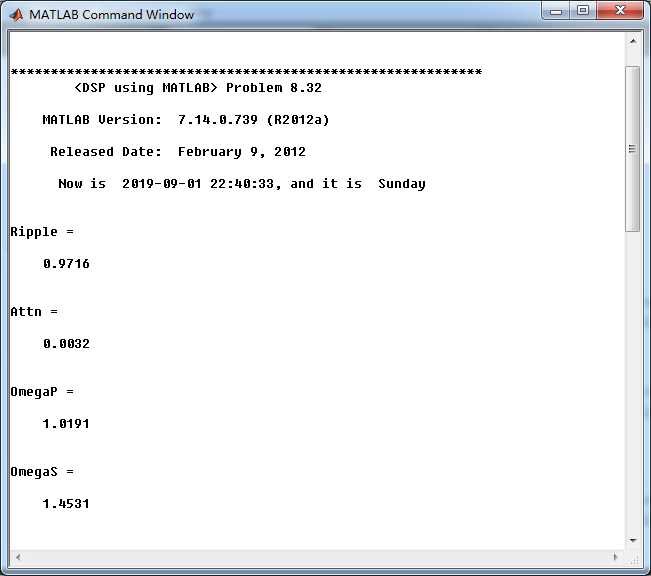
模拟Elliptic原型低通滤波器,系统函数串联形式的系数
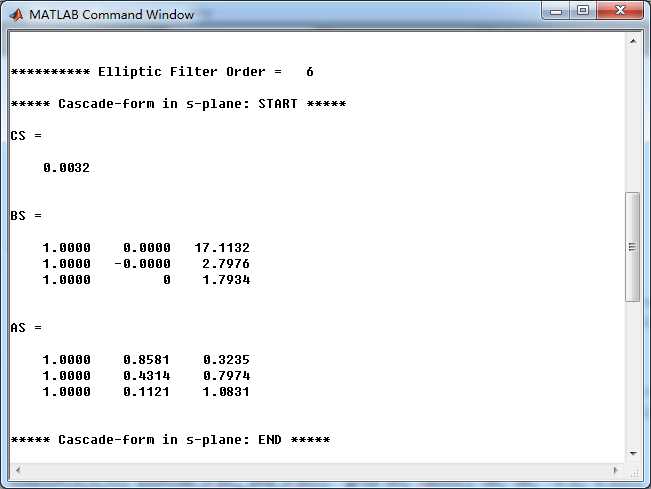
采用双线性变换法,得到数字Elliptic低通滤波器,系统函数直接形式的系数,转换成串联形式的系数
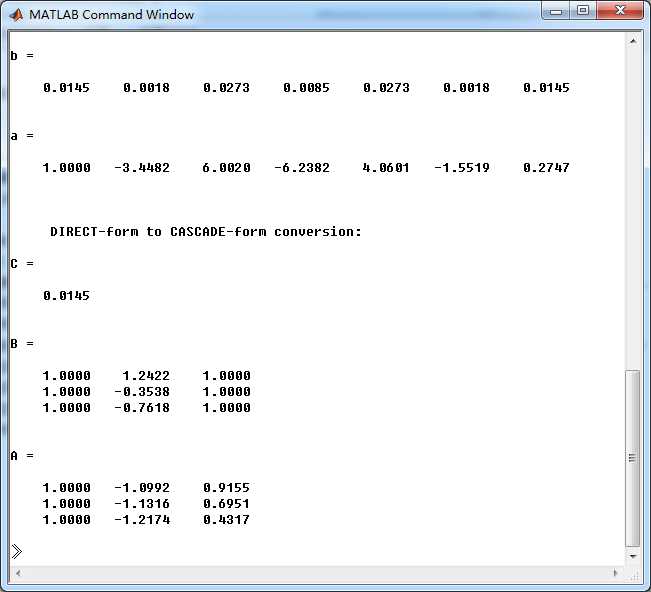
模拟Elliptic原型低通滤波器,其幅度谱、相位谱和脉冲响应
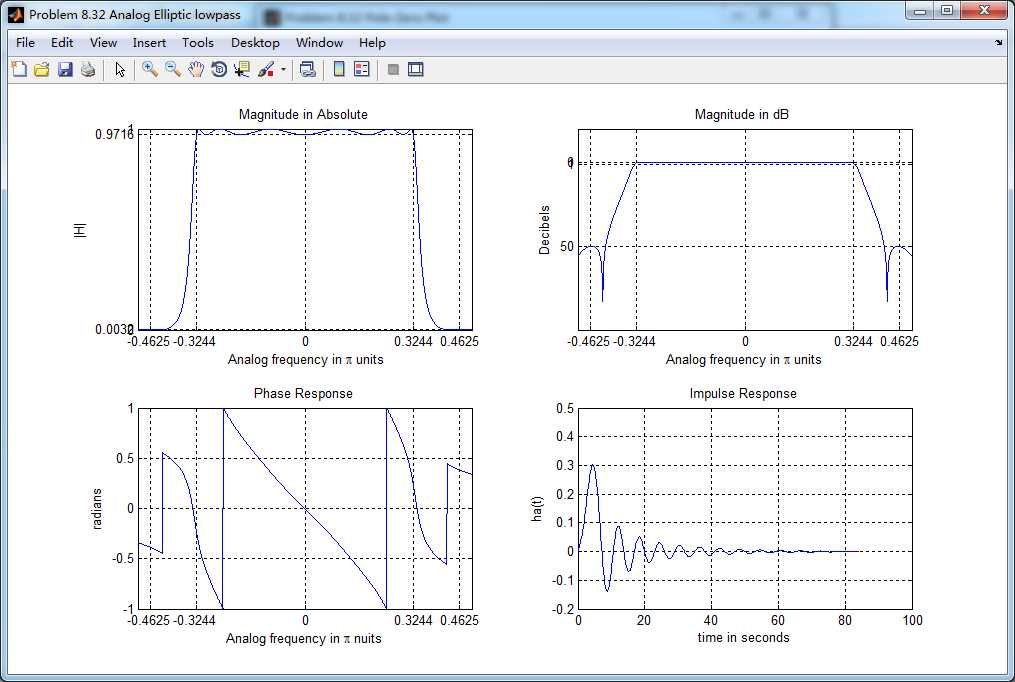
采用双线性变换法(bilinear)得到数字Elliptic低通滤波器,其幅度谱、相位谱和群延迟响应
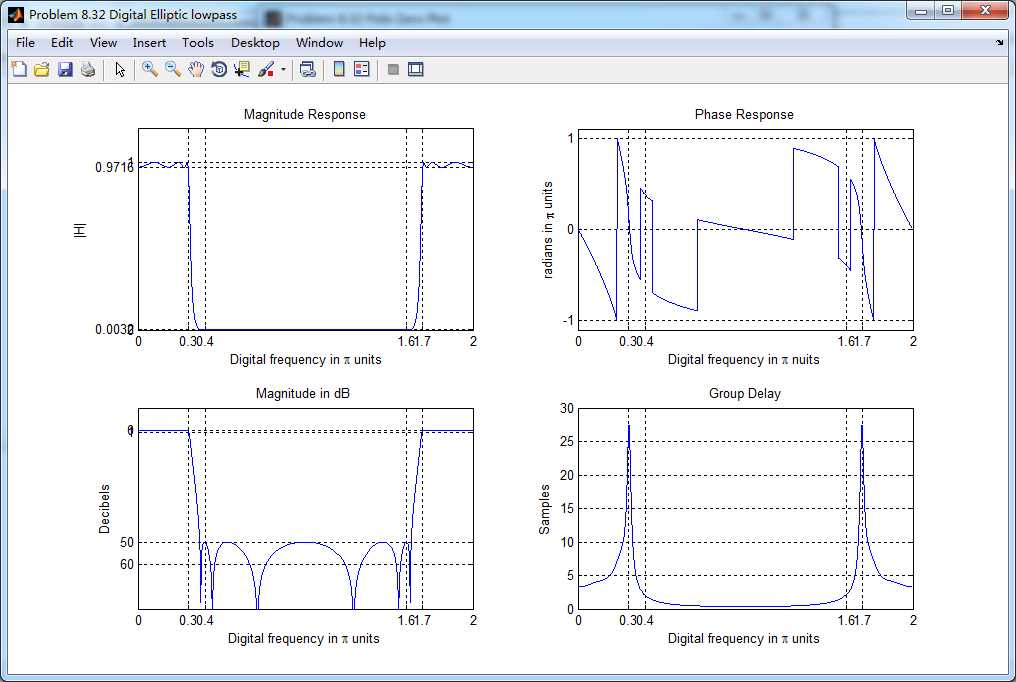
数字Elliptic低通系统函数零极点图

模拟原型和数字低通的脉冲响应对比,可见双线性变换法不保留脉冲响应的形态。
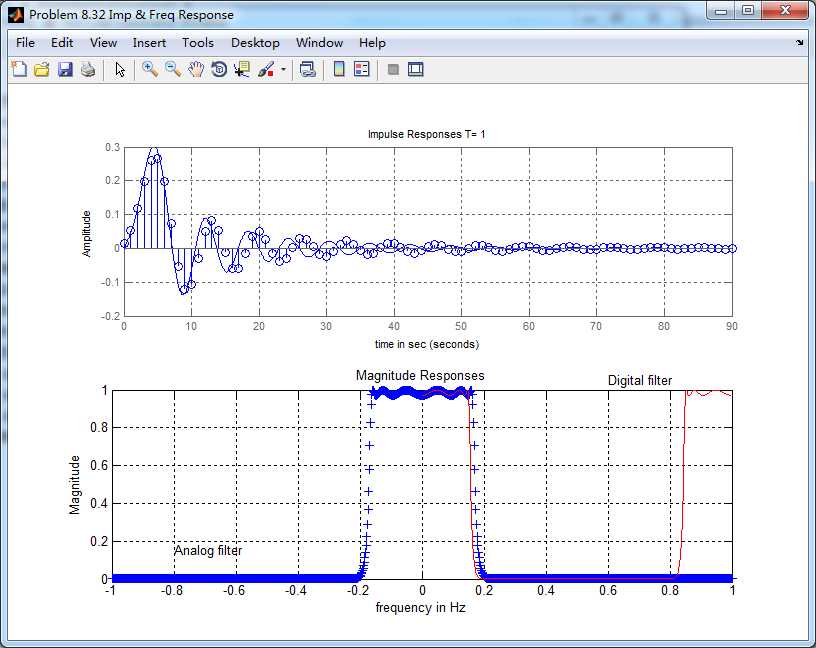
使用MATLAB自带ellip函数的运算结果这里就不写了,只放张幅度谱、相位谱和群延迟响应的图,可见和双线性变换法得到的结果相比,区别不大。
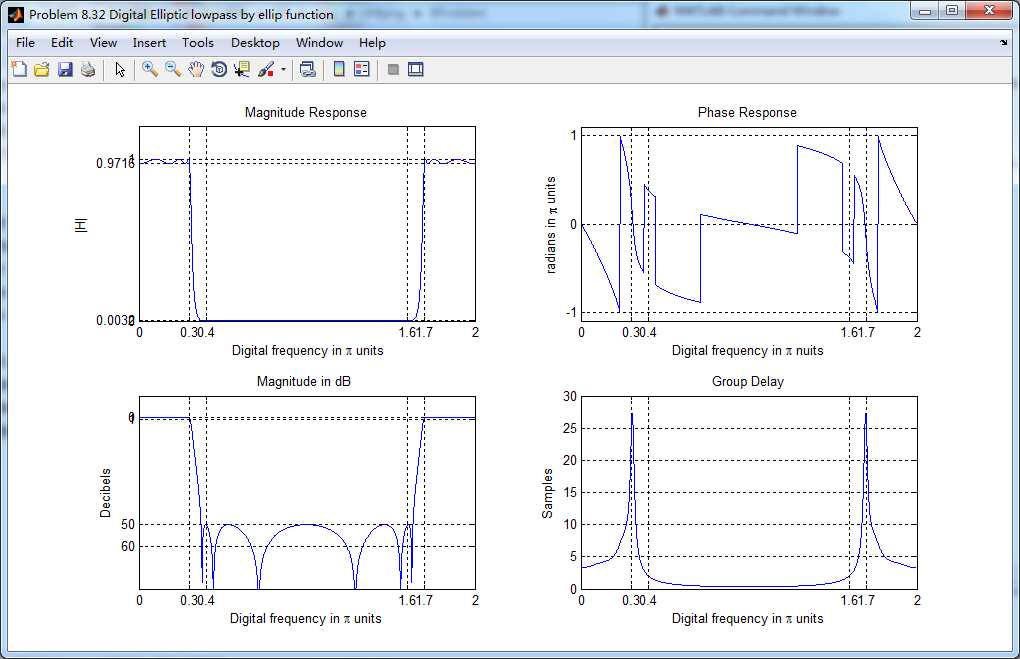
《DSP using MATLAB》Problem 8.32
标签:对比 amp format 自带 gap gas div mode 图片
原文地址:https://www.cnblogs.com/ky027wh-sx/p/11623665.html